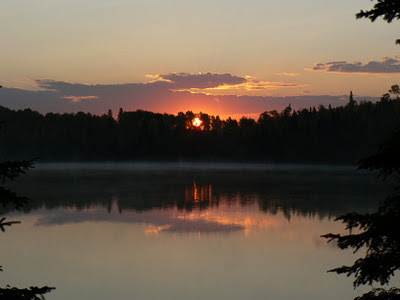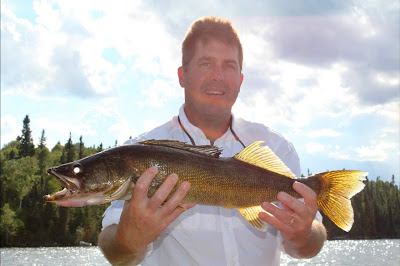
At Bow Narrows Camp we provide comfortable PFDs for all our guests. PFDs are personal floatation devices which most people would call lifejackets. There is a technical difference, however. The Coast Guard requires lifejackets to float a person face up even when they are unconscious. For this reason lifejackets are bulkier, usually of a keyhole design worn around the neck, are uncomfortable and just about never worn.
PFDs, on the other hand, are slender vests or inflatable suspenders that keep a person afloat as long as they are able to turn themselves right side up. They are very comfortable and should be worn any time you are in a boat. All our staff wear them. Brenda and I wear them. All professional outdoors people such as conservation officers, biologists, etc., wear them. So do police officers.
And PFDs, despite the objection of the Coast Guard, are also known by everyone as "lifejackets."
Not wearing a PFD or "lifejacket" is about as smart as not wearing a seatbelt in an automobile or not wearing a helmet when you play football.
Why the Coast Guard doesn't make wearing PFDs mandatory is beyond me. Canadian Coast Guard regulations only state there must be a PFD or lifejacket for each person in the boat. You don't legally have to wear one. Stupid, stupid, stupid!
Well, make sure you are smarter. Always wear your PFD.
In the photo, long-time Bow Narrows angler Charles Howard wears a comfortable PFD.
I think the problem comes from the Coast Guard also being responsible for Maritime shipping regulations. You know, ships as long as football fields. They apply the same rules for the big vessels to recreational boats. But there is a huge difference. Ships sink, boats capsize.
When a person needs a lifejacket aboard a ship, it probably comes after hearing an announcement on the PA system, "Now hear this, this is your captain speaking, all passengers are ordered to report to their muster stations and don lifejackets."
When you need a PFD aboard a boat it comes a split-second after striking a log or rock. Everything is absolutely normal one moment, and the next you are flung into the water. There is no time to put on your PFD. There isn't even time to shout, "Look out!"
It is heartening to see most of our guests wearing their PFDs these days. Many of them bring their own. That's smart. If you go shopping for them you will find one that is the perfect fit for your build.
Lots of people opt for the self-inflating models. These look like suspenders that are joined behind the neck. They use a CO2 cartridge that inflates the PFD whenever it is immersed in water.
But sadly, there are still some people who just use their PFD for padding on the back of their boat seat or cram it under the bow seat.
To fully understand why you should always wear your PFD, we recommend you visit the Cold Water Boot Camp
website.
Learn from Canadian professor Dr. Gordon Giesbrecht, also known as Professor Popsicle for his studies of hypothermia.
The Boot Camp website has some eye-opening videos on what happens to people who end up in cold water. And when you watch these volunteers struggle in the water, consider that they are professionals who are in the peak of physical condition. Most of us would have an even harder time.
One of the lessons Professor Popsicle teaches is the 1-10-1 rule.
When you hit water that is 7 C or colder, you instinctively hyperventilate. This goes on for about one minute. Don't fight it, he advises, just know that in about a minute your breathing will return to normal. You then have 10 minutes before you lose control of your arms and legs. Finally, it takes one hour, even in the coldest water, before you go into hypothermia, a life-threatening condition.
So, let's consider the situation of a person wearing a PFD whose boat flips or who is thrown from a boat. They will instinctively gasp and ingest water when they hit the cold lake but thanks to their PFD, immediately float on the surface where they can cough up the liquid while waiting for their breathing to slow down. They then have 10 minutes to swim to the boat or shore. Of people who drown in Canada each year, 66% are within 15 metres of safety and 43% are within two metres (about six feet)! They could easily have reached safety in the 10 minutes before the blood flow shuts down to their arms and legs, a self-preservation system that tries to keep the body core warm. Remember, the reason the person is in the water is probably because they hit something, like a deadhead or a reef. These are almost always right near the shoreline, not out in the middle of the lake.
But, let's say somehow the person did end up floating in the middle of the lake. He has at least one hour for someone to pick him up before hypothermia sets in. Hypothermia, incidentally, is when a person's body core temperature plunges. The loss of control of extremities like arms and legs is not technically hypothermia.
Also, a person can extend the onset of hypothermia by getting back into or onto the boat, even if it is filled with water (all boats float, even upside down), huddling with other people in the water, etc. The point is there is ample opportunity for a rescue.
Now, let's take the case of person not wearing a PFD. A few seconds after he is unexpectedly thrown from the boat he would likely be dead. That very first gasp would probably do it. However, in the event he survives the plunge and gets his breathing under control 60 seconds later, he also has 10 minutes to get to safety. If he tries to help someone else in the water, probably also not wearing a PFD, it may take more than 10 minutes at which point his arms and legs become useless and he drowns.
It's really a no-brainer. Always wear your PFD.
Click to go back to our
websiteClick to see the latest on the
blog







